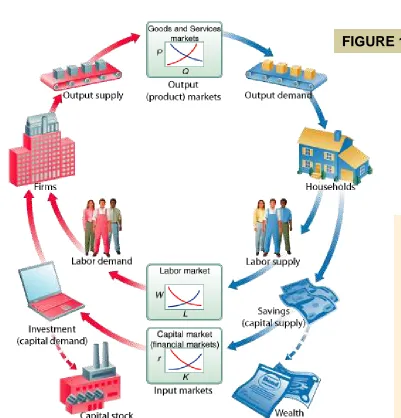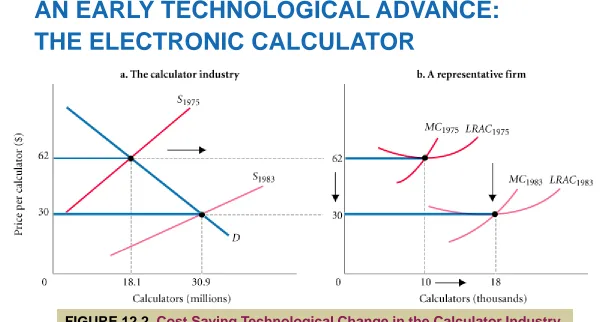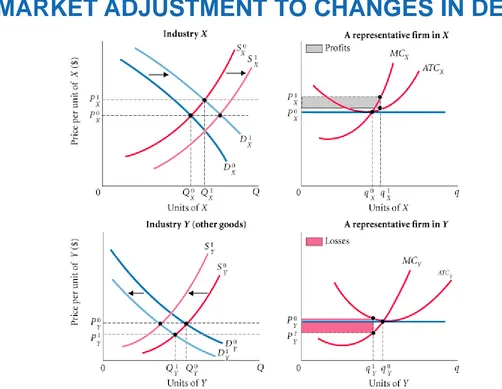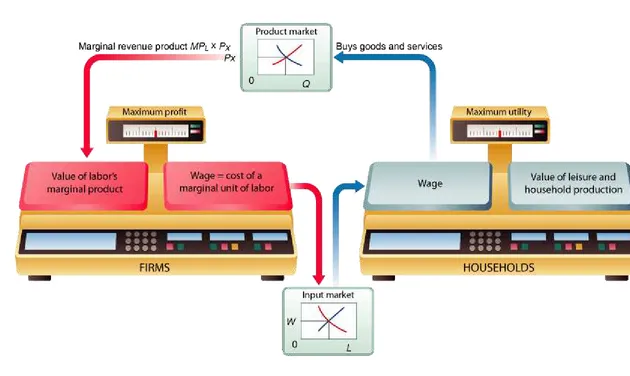Prepared by:
Fernando & Yvonn Quijano
12
Chapter
General Equilibrium
and the Efficiency
CH
and the Efficiency
of Perfect Competition
General Equilibrium Analysis
A Technological Advance: The Electronic Calculator
Market Adjustment to Changes in Demand
Formal Proof of a General Competitive Equilibrium
Allocative Efficiency and Competitive Equilibrium
Pareto Efficiency
The Efficiency of Perfect Competition Perfect Competition versus Real Markets
The Sources of Market Failure
Imperfect Markets Public Goods Externalities
Imperfect Information
CH
GENERAL EQUILIBRIUM AND
THE EFFICIENCY OF PERFECT COMPETITION
FIGURE 12.1 Firm and Household Decisions
Input and output markets cannot be considered separately or as if they
operated independently. While it is important to understand the decisions of individual firms and households and the functioning of individual
CH
GENERAL EQUILIBRIUM AND
THE EFFICIENCY OF PERFECT COMPETITION
partial equilibrium analysis
The process
of examining the equilibrium conditions in
individual markets and for households and
firms separately.
general equilibrium
The condition that
exists when all markets in an economy are
in simultaneous equilibrium.
efficiency
The condition in which the
CH
GENERAL EQUILIBRIUM ANALYSIS
AN EARLY TECHNOLOGICAL ADVANCE:
THE ELECTRONIC CALCULATOR
FIGURE 12.2 Cost Saving Technological Change in the Calculator Industry
A significant—if not sweeping—technological change in a single industry affects many
CH
GENERAL EQUILIBRIUM ANALYSIS
MARKET ADJUSTMENT TO CHANGES IN DEMAND
CH
GENERAL EQUILIBRIUM ANALYSIS
FORMAL PROOF OF A GENERAL COMPETITIVE
EQUILIBRIUM
Economic theorists have struggled with the question of
whether a set of prices that equates supply and
demand in all markets simultaneously can actually exist
when there are literally thousands and thousands of
markets. If such a set of prices were not possible, the
result could be continuous cycles of expansion,
CH
AND COMPETITIVE EQUILIBRIUM
PARETO EFFICIENCY
Pareto efficiency or Pareto optimality
A condition in which no change is
CH
AND COMPETITIVE EQUILIBRIUM
THE EFFICIENCY OF PERFECT COMPETITION
The three basic questions discussed previously included:
1. What gets produced? What determines the final mix of output? 2. How is it produced? How do capital, labor, and land get divided up
among firms? In other words, what is the allocation of resources among producers?
3. Who gets what is produced? What determines which households get how much? What is the distribution of output among consuming households?
CH
AND COMPETITIVE EQUILIBRIUM
Efficient Allocation of Resources among Firms
To determine whether it is efficient
to hire additional clerks at the
Registry of Motor Vehicles, the
cost must be weighed against the
value of people’s time spent
waiting in lines.
CH
AND COMPETITIVE EQUILIBRIUM
Efficient Distribution of Outputs among
Households
CH
AND COMPETITIVE EQUILIBRIUM
Producing What People Want: The Efficient
Mix of Output
The condition that ensures that the right things are
produced is P = MC.
Society will produce the efficient mix of output if all firms equate price and marginal cost.
CH
AND COMPETITIVE EQUILIBRIUM
CH
AND COMPETITIVE EQUILIBRIUM
PERFECT COMPETITION VERSUS REAL MARKETS
We have built a model of a perfectly competitive
market system that produces an efficient allocation
of resources, an efficient mix of output, and an
efficient distribution of output. The perfectly
competitive model is built on a set of assumptions,
all of which must hold for our conclusions to be fully
valid.
CH
THE SOURCES OF MARKET FAILURE
market failure
Occurs when resources are
misallocated, or allocated inefficiently. The
result is waste or lost value.
There are four important sources of market failure:
(1) imperfect market structure, or noncompetitive
behavior,
(2) the existence of public goods,
CH
THE SOURCES OF MARKET FAILURE
IMPERFECT MARKETS
imperfect condition
An industry in which single
firms have some control over price and
competition. Imperfectly competitive industries
give rise to an inefficient allocation of resources.
monopoly
An industry composed of only one
firm that produces a product for which there are
no close substitutes and in which significant
barriers exist to prevent new firms from entering
the industry.
In all imperfectly competitive industries, output is lower—the product is
underproduced—and price is higher than it would be under perfect competition.
The equilibrium condition P = MC does not hold, and the system does not
CH
THE SOURCES OF MARKET FAILURE
PUBLIC GOODS
public goods, or social goods
Goods or
services that bestow collective benefits on
members of society. Generally, no one can be
excluded from enjoying their benefits. The
classic example is national defense.
CH
THE SOURCES OF MARKET FAILURE
Private provision of public goods fails. A completely laissez-faire market system will not produce everything that all members of a society might want. Citizens must band together to ensure that desired public goods are produced, and this is generally accomplished through government spending financed by taxes.
A classic example of a public
good is a park such as
CH
THE SOURCES OF MARKET FAILURE
The market does not always force consideration of all the costs and benefits of decisions. Yet for an economy to achieve an efficient allocation of resources, all costs and benefits must be weighed.
EXTERNALITIES
CH
THE SOURCES OF MARKET FAILURE
The conclusion that markets work efficiently rests heavily on the assumption that consumers and producers have full knowledge of product characteristics,
available prices, and so forth. The absence of full information can lead to transactions that are ultimately disadvantageous.



